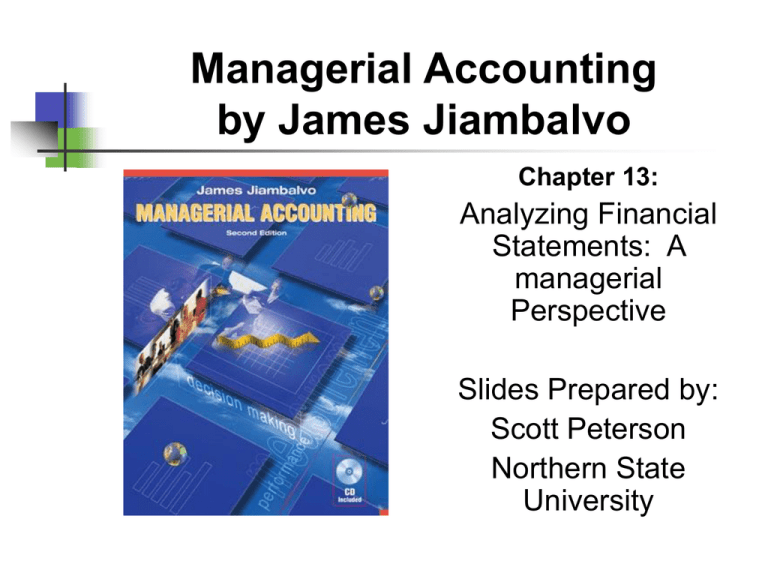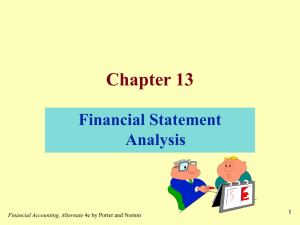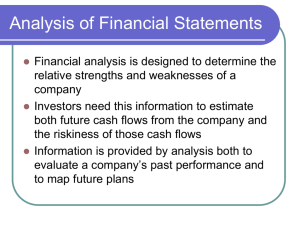
Managerial Accounting
by James Jiambalvo
Chapter 13:
Analyzing Financial
Statements: A
managerial
Perspective
Slides Prepared by:
Scott Peterson
Northern State
University
Objectives
1. Explain why managers analyze financial
statements.
2. Perform horizontal and vertical analysis of the
balance sheet and the income statement.
3. Discuss earnings management and the
importance of comparing net income to cash
flow from operations.
4. Understand how MD&A, credit reports, and
news articles can be used to gain insight into a
company’s current and future financial
performance.
Objectives
(continued)
5. Calculate and interpret profitability
ratios.
6. Calculate and interpret turnover ratios.
7. Calculate and interpret debt-related
ratios.
Why Managers Analyze
Financial Statements
1. To control operations.
2. To asses the financial stability of vendors,
customers and partners.
3. To assess how their companies appear to
investors and creditors.
Control of Operations
1. Examples include:
a. Inventory turnover.
b. Asset turnover.
c. Receivables turnover…
2. Financial analyses help managers
determine whether or not plans and
decisions have been successful.
3. The numbers help tell the story.
Assessment of Vendors,
Customers, and Other
Business Partners
1. Management applies the same analyses to
vendor, customer and other strategic
partner financial statements as they do to
their own.
2. Financial statement analysis used to find,
qualify and monitor potential partners.
Assessment of Appearance To
Investors and Creditors
1. Accrual income vs. cash flow.
2. Notes to financial statements.
Review of the Three Basic
Financial Statements
1. Balance sheet.
2. Income statement.
3. Statement of cash flows.
The Balance Sheet
1. Snapshot at a given point in time.
2. Three categories:
a. Assets
b. Liabilities
c. Equity
3. Basic equation:
Assets = Liabilities + Shareholder Equity
4. Differentiate between current and
noncurrent: 1-year threshold
The Income Statement
1. Statement of operations or a statement
of (accrual) performance over a given
period of time.
2. Revenues, expenses, gains and losses.
3. Basic relationship:
Sales – COGS – Operating Expenses ±
Nonoperating Income (Expense) – Income
Tax = Net Earnings
The Statement of Cash Flows
1. Explanation of the change in cash from
the beginning to the end of an
accounting time period.
2. Categories include:
a. Operating (activities)
b. Investing (activities)
c. Financing (activities)
Horizontal and Vertical
Analysis
1. Horizontal Analysis:
a. Analysis of dollar value and percentage
changes.
b. Over time (left to right).
c. Sometimes called trend analysis.
2. Vertical Analysis:
a. Analysis of dollar value amounts relative to a
common base.
b. Top to bottom.
c. Sometimes called Common Size Statement
Analysis.
Analysis of The Balance Sheet
1. Horizontal Analysis: how have assets,
liabilities and equities changed over time?
2. Vertical Analysis: express all other accounts
relative to total assets.
Analyzing the Income
Statement
1. Horizontal Analysis: how have sales,
expenses, COGS changed over time?
2. Vertical Analysis: express all other accounts
relative to sales.
Earnings Management and The
Need to Compare Earnings and
Cash-Flow Information
1. A fine line between “earnings management
and earnings manipulation.
2. It can and does happen.
a.
b.
c.
d.
Cendant
Enron
Sunbeam
Waste Management
3. You get what you measure, so if you reward
management on earnings….
Other Sources of Information
on Financial Performance
1. Other information is available from thirdparties.
2. Credit reporting services such as Dunn &
Bradstreet.
3. News articles.
4. On-line sources…
5. Edgar
Management Discussion and
Analysis
1. Included in the annual financial reports of
publicly traded companies.
2. Known as MD&A.
3. Provides other financial, statistical,
qualitative and quantitative data along with
explanations.
Credit Reports
1. Credit reports provide information about
company credit history.
2. Many firms provide this service, for a fee.
3. Provides insights about how well a firm has
paid its bills, debts, mortgages, etc…
4. Examples include Dunn & Bradstreet.
News Articles
1.
2.
3.
4.
Many free and fee-for-service sources.
Nexis-Lexis.
Yahoo! Finance.
Thestreet.com
Ratio Analysis
1. Profitability.
2. Turnover.
3. Debt-related.
Profitability Ratios
1.
2.
3.
4.
5.
Earnings Per Share (EPS).
Price-earnings (PE).
Gross margin percentage.
Return on total assets.
Return on common stockholders’ equity.
Turnover Ratios
1.
2.
3.
4.
5.
Asset turnover.
Accounts receivable turnover.
Days’ sales in receivables.
Inventory turnover.
Days’ sales in inventory.
Debt-Related Ratios
1.
2.
3.
4.
Current ratio.
Acid-test (Quick) ratio.
Debt-to-equity ratio.
Times interest earned.
A Managerial Perspective on
The Analysis of HGW’s
Financial Statements
1. Summary of financial statement analysis
objectives:
a. Control operations.
b. Assess stability of vendors, customers
and other business partners.
c. Assess appearance of firm investors and
creditors.
Control of Operations
1.
2.
3.
4.
HGW pressed for discounts from suppliers.
Has that plan been effective?
No! Gross margins are still about 30%.
Gross margins should be lower from one
period to the next if goods were obtained at
a lower price.
Stability of Vendors,
Customers, and Other
Business Partners
1. HGW considered outsourcing the IT function
to CosmosSolutions, Inc.
2. What steps should HGW take to investigate
this potential partner?
3. Financial analysis of Cosmos, D&B report,
news articles, etc…
Appearance To Investors and
Creditors
1. What additional information can the CEO or
HGW give to investors, creditors, analysts?
2. What questions should be anticipated by the
CEO of HGW given the current financial
analysis?
3. Day’s sales in inventory is more than 120
days.
4. The CEO should prepare some solid
answers.
Summary of Analyses
1.
2.
3.
4.
5.
Horizontal analysis.
Vertical analysis.
Profitability ratios.
Turnover ratios.
Debt related ratios.
Quick Review Question #1
1. Horizontal analyses
a. Compare one company with
another.
b. Evaluate profitability.
c. Anticipate questions from creditors.
d. Allow a firm to compare balances
from one year to another.
Quick Review Answer #1
1. Horizontal analyses
a. Compare one company with
another.
b. Evaluate profitability.
c. Anticipate questions from creditors.
d. Allow a firm to compare its own
balances from one year to another.
Quick Review Question #2
2. The difference between current ratio and
quick ratio is
a. The current ratio includes depreciation
expense.
b. The acid-test ratio uses only monthly
data.
c. The acid-test ratio excludes inventory
from the numerator of the ratio.
d. The current ratio is more current.
Quick Review Answer #2
2. The difference between current ratio and
quick ratio is
a. The current ratio includes depreciation
expense.
b. The acid-test ratio uses only monthly
data.
c. The acid-test ratio excludes inventory
from the numerator of the ratio.
d. The current ratio is more current.
Quick Review Question #3
3. MD&A consists of
a. Financial ratios.
b. Horizontal and vertical analyses.
c. Management discussion and
analysis.
d. Monthly discounts and advertising.
Quick Review Answer #3
3. MD&A consists of
a. Financial ratios.
b. Horizontal and vertical analyses.
c. Management discussion and
analysis.
d. Monthly discounts and advertising.
Quick Review Question #4
4. Beginning inventory is $42,000. Ending
inventory is $30,000. COSG is $320,000.
Inventory turnover is
a. 10 times.
b. 9.2 times.
c. 8.89 times.
d. 1.4 times.
Quick Review Answer #4
4. Beginning inventory is $42,000.
Ending inventory is $30,000. COSG is
$320,000. Inventory turnover is
a. 10 times.
b. 9.2 times.
c. 8.89 times.
d. 1.4 times.
Copyright
© 2004 John Wiley & Sons, Inc. All rights reserved.
Reproduction or translation of this work beyond that
permitted in Section 117 of the 1976 United States
Copyright Act without the express written permission of the
copyright owner is unlawful. Request for further information
should be addressed to the Permissions Department, John
Wiley & Sons, Inc. The purchaser may make back-up
copies for his/her own use only and not for distribution or
resale. The Publisher assumes no responsibility for errors,
omissions, or damages, caused by the use of these
programs or from the use of the information contained
herein.









